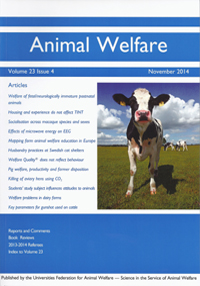Document type : scientific article published in Animal Welfare
Authors: T.J. Bergstra, H. Hogeveen, E.N. Stassen, A.G.J.M. Oude Lansink
Preview: In response to the public concerns about animal welfare in swine husbandry, the pig (Sus scrofa domesticus) sector introduced improved measures to focus on single rather than multiple dimensions of animal welfare concerns without accounting for their impact on public attitudes. These measures failed to improve attitudes to pig husbandry. The present study uses a more comprehensive approach by evaluating animal welfare measures in terms of their effect on animal welfare, farm income and public attitudes. Four measures were defined for each of the following societal aspects of sow husbandry: piglet mortality; tail biting and the indoor housing of gestating sows. A simulation model was developed to estimate the effects of the measures and Data Envelopment Analysis used to compare measures in terms of their effects on animal welfare, farm income and public attitudes. Only piglet mortality measures were found to have a positive effect on farm income but they showed a relatively low effect on animal welfare and public attitudes. The most efficient measure was that which included straw provision, daylight and increased group sizes for gestating sows. The level of improvement of a measure on animal welfare did not necessarily equate to the same level of improvement in public attitudes or decrease in farm income.
Published on ufaw.org.uk, 15 December 2020: Improvements in animal welfare do not automatically change public opinion or decrease farm income






